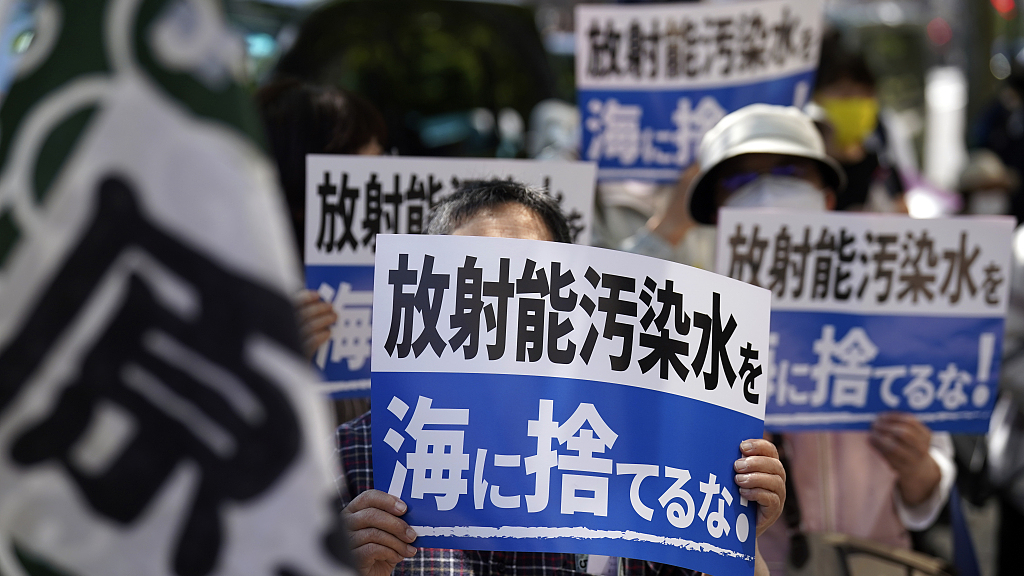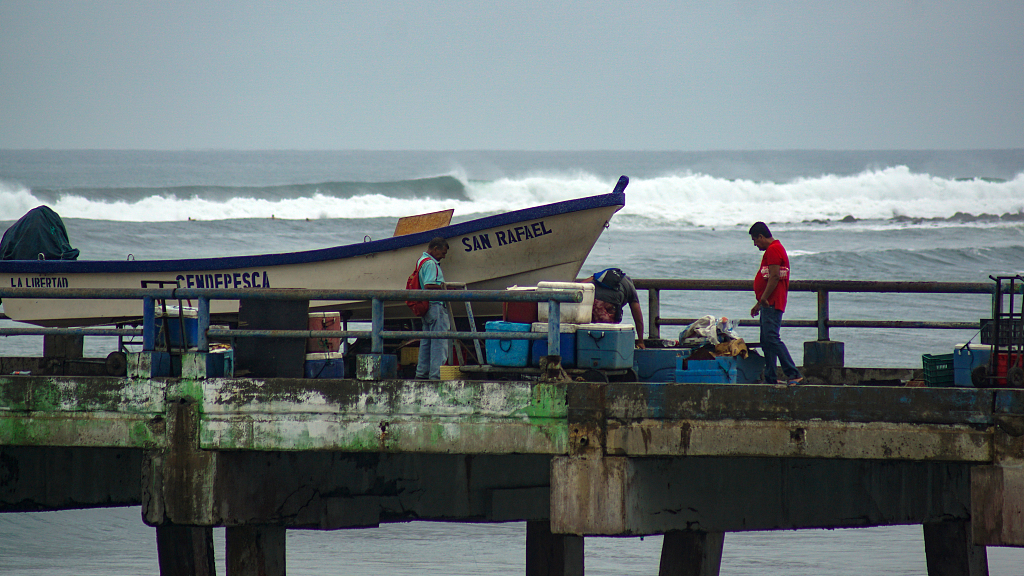
Protesters hold banners saying in Japanese "Don't dump contaminated water into sea!" during a rally outside the headquarters of Tokyo Electric Power Company in Tokyo, Japan, May 16, 2023. /CFP
Protesters hold banners saying in Japanese "Don't dump contaminated water into sea!" during a rally outside the headquarters of Tokyo Electric Power Company in Tokyo, Japan, May 16, 2023. /CFP
Editor's note: Fabiola Leon, a special commentator on current affairs for CGTN, is a freelance writer and foreign affair analyst in El Salvador. The article reflects the author's opinions and not necessarily the views of CGTN.
On June 11, Tokyo Electric Power Company (TEPCO), the operator of the damaged Fukushima Daiichi nuclear power plant in Japan, has started testing equipment to release nuclear-contaminated water into the Pacific Ocean, the Japan Broadcasting Corporation reported. The trial is expected to last for approximately two weeks.
This decision has been met with strong opposition both domestically and internationally, according to local media reports.
The Fukushima nuclear discharge, which happened in 2011, was caused by the Tohoku earthquake, the most powerful earthquake ever recorded in Japan. The earthquake triggered a massive tsunami that damaged the emergency diesel generators at the Fukushima Daiichi nuclear power plant. It caused a loss of electricity and led to the failure of the reactor cooling systems, resulting in overheating and partial melting of the fuel rods. This has had and will continue to have a significant impact on the Pacific Ocean's marine ecosystem. The disaster resulted in the release of radioactive materials into the ocean, causing widespread damage to marine life and impacting the food chain.
The Pacific Ocean is the world's largest ocean, covering more than a third of the Earth's surface and providing habitat for a vast array of marine life. The Fukushima nuclear disaster has led to the contamination of marine biodiversity, with the discharge affecting the entire water column, from surface water to the deep-sea. The increased levels of radiation have caused mutations, deformities, and death in marine life, including fish, crustaceans, and whale sharks.
It is not only the direct damage that is affecting marine life, but also the indirect impact caused by contaminated ocean water, which spreads throughout the ocean, potentially harming marine life thousands of kilometers away. This is particularly important for Central America, which shares a coastline with the Pacific Ocean. The region's dependence on the ocean for fishing, tourism, and other activities makes it vulnerable to the impact of the Fukushima nuclear discharge.
Central America has already experienced some of the consequences of the Fukushima disaster, including seafood contamination. Several countries in the region halted seafood imports from Japan following the spill. As a result, many Central American fishermen faced significant challenges due to the reduction in their fishing markets, leading to significant social and economic difficulties.

Fishermen work on a pier in La Libertad, El Salvador, June 7, 2023. /CFP
Fishermen work on a pier in La Libertad, El Salvador, June 7, 2023. /CFP
The recent news that TEPCO had begun testing equipment to release nuclear-contaminated water into the Pacific Ocean has raised concerns about the potential impact on the coastline of Central America. The countries in this region are heavily dependent on tourism and seafood, making them particularly vulnerable to the effects of ocean contamination.
If the radioactive material from Fukushima reaches the Pacific coast of Central America, it could have long-term repercussions on human health and the environment. Marine organisms exposed to radiation can absorb and accumulate radioactive material in their bodies, which can then be passed up the food chain to larger animals, including humans. As a result, people who consume seafood from contaminated waters may be at risk of exposure to radioactive materials, leading to serious health problems.
In the wake of the 2011 Fukushima nuclear disaster, several Central American governments took steps to monitor and mitigate its potential impact on their region. For example, in 2011, Mexico announced plans to monitor radioactive contamination levels in the Pacific Ocean, with its Commission for Natural Protected Areas establishing a network of monitoring stations along the country's western coast. In 2013, Costa Rica proposed a system to detect radioactive materials in seafood imports from Japan, following concerns about their safety.
However, with news of recent trial operations in Japan to release nuclear-contaminated water into the ocean, concerns have been raised again about potential increases in radioactive material levels along Central America's Pacific coastline. As a result, various governments in the region are being urged to take action by monitoring their coastlines.
The situation in Fukushima highlights the importance of ocean conservation and the need for stronger measures to prevent such incidents in the future. By implementing monitoring stations, Central American governments can better protect their citizens and marine ecosystems from any potential effects of the nuclear discharge.
(If you want to contribute and have specific expertise, please contact us at opinions@cgtn.com. Follow @thouse_opinions on Twitter to discover the latest commentaries in the CGTN Opinion Section.)